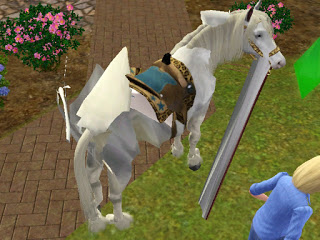
The desire to avert this trope is why Animals Fear Neutering. Contrast Non-Mammal Mammaries, when animals have breasts and/or nipples when they shouldn't have. See also Appropriate Animal Attire for a broader discussion of modesty and clothing as it applies to animals. Sub-Trope of Anatomy Anomaly, and related to Barbie Doll Anatomy (the human version). Many real life animals have visible genitalia, so listing aversions that involve actual animals would be unnecessary. Note: When adding examples, limit aversions to instances in which the animals are drawn, rendered in CGI, or are otherwise not real. For cases where a creature is sufficiently anthropomorphized that the Uncanny Valley effect might occur (such as with Funny Animals in a few cases and especially with Beast Folk), see Non-Humans Lack Attributes instead. not visibly anthropomorphized) and animal mannerisms should be considered. Japanese Media also tends to avert this with male tanuki, which are often depicted as having gigantic testicles as a symbol of luck.įor the purposes of defining examples, only animals who are mostly or "completely" normal in physical appearance (e.g. The only time cow udders were ever censored was in the early 1930s, when Moral Guardians became offended by the showing of Clarabelle Cow's bare udders in the 1930 Disney short "The Shindig." Other female mammals, even goats, are almost never shown with explicit mammaries, even in scenes where her offspring are shown nursing from her. The sole exception to this censorship in Western media is the four teats of the female cow (and also quite often the male cow), which are always present, thanks to the iconic image of the country milkmaid.

There are also some animals that can actually retract their genitalia when not using them, such as the aforementioned echidnas. As a rule of thumb, mammals that live further north will have thicker and longer fur and are more likely to justify this as the longer fur protects their naughty bits from the cold. However, fur mostly concealing the animal's genitalia is actually the case in some animals. Anyone who has seen a male pig, male cattle, or male dog (both desexed and intact ones), for example, will have no doubt noticed the prominent pair of features (testicles in intact ones, penises in both) between its rear legs (and on the belly in the case of dogs and cattle).

Also, many species' coats of fur are just too short to adequately conceal the features of their genital or anal area in the first place.

However, observation of most real mammals will show that their fur is actually thinner in those places (so it doesn't get soiled when nature calls, and is easier to clean if it does). On the other hand, when depicting mammals (aside from monotremes platypodes and echidnas), there's a common assumption that an animal's natural fur will adequately preserve the creature's modesty. It isn't the case with male cartilaginous fishes, which have claspers to facilitate copulation in reality. This is technically Truth in Television for animals such as birds, reptiles, amphibians, bony fish, and invertebrates, whose genitalia are typically visible only as a small underside "vent" between the rear limbs (and easy to miss even without feathers or scales to obscure them).


 0 kommentar(er)
0 kommentar(er)
